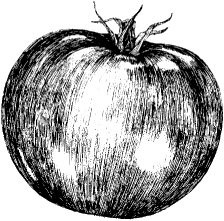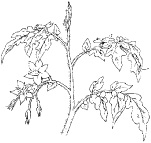Grow the Best Tomatoes
Revised and Updated
John Page
CONTENTS
Introduction
The tomato, Lycopersicon esculentum, is a fruit that we use as a vegetable. It is one of the few vegetables native to the Americas. It was first known as a food in Peru. Until a couple of centuries ago, it was grown only as an ornamental and was dubbed the love apple.
For a plant that was thought to be deadly poison in colonial times, the tomato has made up a lot of ground. It is now the most popular vegetable in our gardens. Why shouldnt it be? It can be used in so many ways, from eating single ripe ones in the garden, to frying them green, from making preserves from green and ripe ones, to pickling green and ripe ones, on into mincemeat, paste, juice, stew, soups, salads the uses are endless.
Delete the tomato from all of your cookbooks, and youll leave a hole that you can drive all the other vegetables through.
The Nature of Tomatoes
The tomato is actually a perennial; if the weather never got cold and if summer or tropical conditions continued to prevail, it would keep on growing for a long time. But as it is grown in virtually every part of the United States, the tomato acts more like an annual, and is treated by gardeners as if it were annual which means it has to make it from seed to seed in a single growing season.
We consider the tomato to be a heat-loving crop. It doesnt do well until the soil warms up to 65F or more, and until nighttime temperatures get up into the 50s. This occurs in late May in our northern areas; but if we planted seed at that time, the season wouldnt be long enough to get ripe tomatoes most years. Therefore, we have to lengthen the season by getting the plants started indoors or under protected conditions so that they are already several weeks into their growing season when soil and air reach optimal temperatures.

As we go south and reach the rough climatic equal of Chesapeake Bay, it becomes possible to start with seed in the garden and get ripe tomatoes each year. But even in these warmer areas, why not get your first tomato plants started inside, before the outdoor weather is ready? They will ripen earlier, and you can also plant seed when the time comes. Then you can have fresh tomatoes over a longer season.
The tomato isnt a particularly hard plant to grow, and to grow well, which is just as well since it it perhaps the single most popular vegetable garden plant grown in this country. Some folks are determined to make it difficult, however, and these efforts are usually centered on getting a tomato or two earlier than anybody else. This obsession with early fruit makes sense only for market growers, who can profit heavily from being the earliest. If you have gone to the trouble of getting tomatoes the size of golf balls before transplanting time, you are a hybrid between a gardener and a greenhouse grower. If its your claim to fame, great! I figure that getting a six- or eight-week start on the weather is cheating enough and keeps me in the gardener category. I shall proceed to consider tomatoes a garden crop and not a greenhouse crop.


Determinate tomato plants (left) have flowers on the ends of their branches, and indeterminate varieties (right) flower along their stems.
Tomatoes come in two different types, determinate and indeterminate. Determinate tomatoes produce fruit at the ends of their branches. They stop growing while they are fairly short. Indeterminate types, in contrast, produce fruit at intervals along their ever-growing stems. They keep growing throughout the season until frost stops them. Most gardeners will not care whether they are growing determinate or indeterminate tomatoes. Staking and pruning are the only activities that could cause trouble if you dont know which type you are working on. Seed packets, labels, and catalogs should always say which type you are buying.
Growing Conditions
Unless you are fortunate in soil and site, some parts of the garden offer better growing conditions than others. Give tomatoes one of the good sites. The soil must be well drained with full sun. If it isnt well drained, youd better do some drainage work. If it isnt in full sunlight, youd better do some forestry work. Once you have selected a good site, dont plant tall peas or corn to the south of the tomatoes; these cast shadows on sun-loving tomatoes. If you have a choice, choose a south-facing slope and avoid north-facing slopes.
Soil
We say the kind of soil necessary to grow tomatoes well isnt different from the soil conditions necessary for growing any other vegetable well, except that when we say this about tomatoes, we really mean it. They like the best of what your garden has to offer. You can chisel a little on corn and beans, but not on tomatoes. You will need to know what sort of soil you are dealing with, so start with a soil test that measures pH, nutrients, and texture if you dont already have that information.
Then put the p up there to 6.5 or thereabouts with lime. It wont do any harm to use high-magnesium lime, as long as you dont have a magnesium test to tell you you dont need it. Your starting p and soil condition will determine how much lime you need, but you can count on needing about 2 pounds of limestone per 100 square feet of sandy soil, 6 pounds for loamy soil, and 9 pounds for clay soil to raise your p from 5.5 to 6.5.
Once it is limed, you can make a garden soil out of some pretty poor earth by tilling in rotted manure at the rate of one pound per square foot. If you have already burned out the organic matter with years of gardening, till in a dose in the fall and another in the spring.
If you dont have and cant get well-rotted manure, get a load of fresh manure, but get it a year early. In a years time, it will be the well-rotted manure people are always writing about. Any kind of manure will do, but cut the amount in half if you opt for poultry manure.
If you are gardening a new piece of soil, your soil test will help you to determine levels of phosphorus and potassium as well as give you the lime requirements. The rotted manure will correct most deficiencies. So get on the manure program, which takes care of both fertility and organic matter problems.
If you really cant get manure, then youd better go the green manure route, along with commercial fertilizer with frequent soil tests to keep the soil on an even keel. Soil that is manipulated to grow good tomatoes will grow good vegetables in general.
Gardeners should stop complaining about their soil being too light, too sandy, or too heavy, like clay. The solution to all of these is to keep the level of organic matter high. Manure, green manure, and compost all keep sand from behaving like sugar and clays from behaving like brick. Few of us, indeed, start with a soil that isnt too heavy or too light, and its your job to make what you have good enough to grow tomatoes. It really isnt that difficult. If you keep up with adding compost or manure every year or even every spring and fall you will end up with great soil, no matter how you started out.
Green Manures




